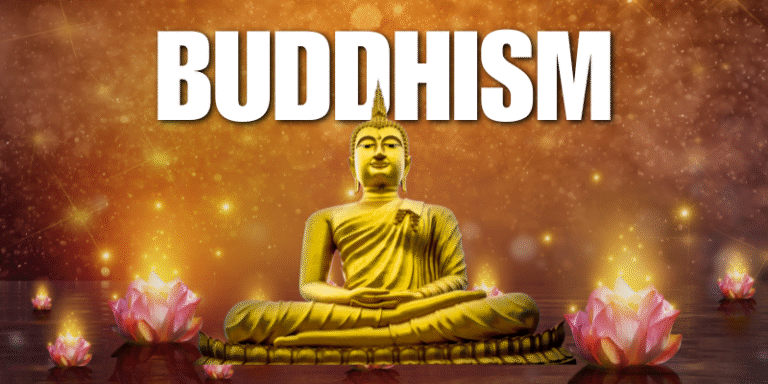Buddhism, rooted in the teachings of Siddhartha Gautama—the Buddha—offers a comprehensive framework for understanding and overcoming suffering. Central to this philosophy are the Four Noble Truths and the Noble Eightfold Path, first expounded in the Dhammacakkappavattana Sutta shortly after the Buddha’s enlightenment (Gethin, 1998). These foundational doctrines provide both a diagnosis of the human condition and a path toward liberation (nibbāna).
The Four Noble Truths
1.0 Dukkha (Suffering)
The First Noble Truth asserts that life is inherently marked by suffering, known as dukkha. This includes not only physical pain but also emotional and existential dissatisfaction. Birth, ageing, illness, and death are all seen as forms of dukkha (Rahula, 1974). The concept extends beyond overt suffering to subtler forms of dissatisfaction stemming from impermanence and unfulfilled desires (Harvey, 2013).
2.0 Samudaya (Origin of Suffering)
The Second Noble Truth identifies taṇhā (craving or thirst) as the origin of suffering. Craving for sensory pleasure, existence, or non-existence binds individuals to the cycle of rebirth (saṃsāra) (Gethin, 1998). This craving arises from ignorance (avijjā) and leads to clinging and becoming, which perpetuate suffering (Lopez, 2001).
3.0 Nirodha (Cessation of Suffering)
The Third Noble Truth states that the cessation of suffering is possible through the eradication of craving. This state of liberation is known as nibbāna, described as the extinction of greed, hatred, and delusion (Harvey, 2013). It represents the ultimate goal of the Buddhist path—freedom from the cycle of rebirth and suffering.
4.0 Magga (Path to the Cessation of Suffering)
The Fourth Noble Truth outlines the method to attain nibbāna—the Noble Eightfold Path (Ariya Aṭṭhaṅgika Magga). This path encompasses ethical conduct, mental discipline, and wisdom. The Buddha likened it to a middle way that avoids both extreme asceticism and sensual indulgence (Rahula, 1974).
The Noble Eightfold Path
The Noble Eightfold Path is traditionally divided into three categories: wisdom (paññā), ethical conduct (sīla), and mental discipline (samādhi). These elements are not sequential but are to be developed simultaneously.
1.0 Wisdom (Paññā)
- Right View (Sammā-diṭṭhi): This involves understanding the Four Noble Truths and seeing reality as it truly is. Right view is considered the foundation of the entire path (Gethin, 1998).
- Right Intention (Sammā-saṅkappa): This entails intentions of renunciation, goodwill, and harmlessness, countering desires rooted in attachment and aversion (Harvey, 2013).
2.0 Ethical Conduct (Sīla)
- Right Speech (Sammā-vācā): Involves abstaining from lying, divisive speech, harsh language, and idle chatter, and instead speaking truthfully and harmoniously (Rahula, 1974).
- Right Action (Sammā-kammanta): This includes refraining from killing, stealing, and sexual misconduct, thereby cultivating moral behaviour (Gethin, 1998).
- Right Livelihood (Sammā-ājīva): Buddhists are urged to earn a living without harming others, avoiding trades such as dealing in weapons, living beings, and intoxicants (Harvey, 2013).
3.0 Mental Discipline (Samādhi)
- Right Effort (Sammā-vāyāma): This is the effort to abandon unwholesome states and cultivate wholesome mental habits (Lopez, 2001).
- Right Mindfulness (Sammā-sati): Right mindfulness entails being aware of one’s body, feelings, thoughts, and mental objects, which is foundational to Buddhist meditation (Gethin, 1998).
- Right Concentration (Sammā-samādhi): This refers to the development of deep meditative absorption (jhāna), leading to tranquillity and insight (Harvey, 2013).
Interconnection of the Path and the Truths
The Noble Eightfold Path is the practical means of realising the Four Noble Truths. The first three truths outline the problem of suffering, its origin, and its cessation, while the fourth truth—the Path—offers the solution. As such, the path is not merely moralistic but transformative, aiming to purify the mind and liberate the individual from cyclic existence (Gombrich, 2009).
Philosophical Implications
Buddhist philosophy is notable for its empirical and experiential approach. Unlike dogmatic religious systems, it encourages practitioners to verify teachings through personal experience. The Buddha himself stated: “Ehipassiko”— “come and see”—inviting inquiry rather than blind faith (Rahula, 1974).
Furthermore, the Four Noble Truths can be seen as a psychological model: identifying a problem (suffering), diagnosing its cause (craving), proposing a solution (cessation), and prescribing a remedy (the Path) (Wallace, 2006). This resonates with cognitive-behavioural approaches in modern psychology, which similarly seek to identify and transform harmful thought patterns (Kumar, 2002).
Contemporary Relevance
In contemporary times, Buddhist concepts like mindfulness (sati) have been adapted into secular therapeutic practices such as Mindfulness-Based Stress Reduction (MBSR) and Mindfulness-Based Cognitive Therapy (MBCT). These interventions draw directly from the Eightfold Path, particularly the cultivation of mindfulness and ethical living (Kabat-Zinn, 1990; Segal et al., 2002).
Moreover, modern scholars argue that the Four Noble Truths form a “scientific spirituality”, offering a method for self-examination and ethical transformation rather than a metaphysical belief system (Batchelor, 1997). This has made Buddhism increasingly relevant in pluralistic, post-secular societies.
The Four Noble Truths and the Noble Eightfold Path form the core of Buddhist philosophy, offering a sophisticated analysis of human suffering and a path to its cessation. Through a balanced cultivation of wisdom, ethical conduct, and mental discipline, the teachings provide a practical framework for spiritual development. Their enduring relevance—philosophically, ethically, and psychologically—continues to influence both traditional Buddhist communities and modern secular audiences.
References
Batchelor, S. (1997) Buddhism Without Beliefs: A Contemporary Guide to Awakening. London: Bloomsbury.
Gethin, R. (1998) The Foundations of Buddhism. Oxford: Oxford University Press.
Gombrich, R. (2009) What the Buddha Thought. London: Equinox Publishing.
Harvey, P. (2013) An Introduction to Buddhism: Teachings, History and Practices. 2nd ed. Cambridge: Cambridge University Press.
Kabat-Zinn, J. (1990) Full Catastrophe Living: Using the Wisdom of Your Body and Mind to Face Stress, Pain and Illness. New York: Delacorte.
Kumar, K. (2002) ‘Application of Buddhist Principles in Cognitive Behaviour Therapy’, Journal of Human Values, 8(1), pp. 29–38.
Lopez, D.S. (2001) The Story of Buddhism: A Concise Guide to Its History and Teachings. New York: HarperOne.
Rahula, W. (1974) What the Buddha Taught. London: Gordon Fraser.
Segal, Z.V., Williams, J.M.G. and Teasdale, J.D. (2002) Mindfulness-Based Cognitive Therapy for Depression: A New Approach to Preventing Relapse. New York: Guilford Press.
Wallace, B.A. (2006) The Attention Revolution: Unlocking the Power of the Focused Mind. Boston: Wisdom Publications.









